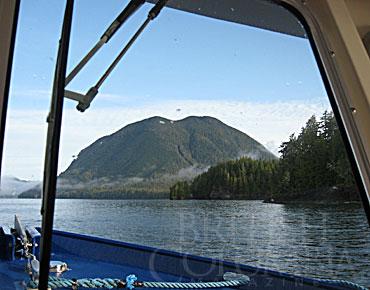
Wikipedia thinks it is a cinder cone. So does Tourism Tofino. A writer for the publication, Tofino Time, even gushed: “There certainly is something about being on a massive dormant cinder cone amidst giant ancient trees; it is, without a doubt, good for the soul.”
Truth is, I was also suckered in by this coastal myth. Some months ago I hiked up Lone Cone after a short water taxi ride from Tofino, took notes of the experience, snapped photos of the amazing vista. Then I wrote it into my British Columbia Magazine feature on volcanoes: “While others surfed or beach walked, I took a boat to Meares Island and scrambled up Lone Cone, a forested volcano that sits largely unrecognized near Tofino.”
Only after my editor prodded me to check out a rumour did I learn the truth: Lone Cone has zero volcanic history. Not dormant. Not even extinct.
“Lone Cone is not a volcano, but one of the Catface Intrusions,” explained Melanie Kelman, a volcanologist with the Geological Survey of Canada. “These are masses of quartz diorite that intruded the Westcoast Crystalline complex. At least one of them has been dated, at about 41 million years old.”
How did the myth of Lone Cone develop?
“I’ve been asked a lot of questions, but this is a first,” responded Tofino amateur historian Ken Gibson, 75. “If you look at it from the sea, it stands out very much by itself and very much as a cone.” The landmark is identified in early historic journals, and became the title of a small book published in 1945 by Vargas Island pioneer Dorothy Abraham: Lone Cone?A journal of life on the west coast of Vancouver Island.
It would be nice to speculate that the cloud that often hangs atop Lone Cone could be confused with volcanic steam. But Gibson thinks that’s a stretch. Perhaps it’s nothing more than confusion over the cone reference.
All we know for sure: don’t believe everything you read on the web.
Even after you’ve seen it for yourself.

